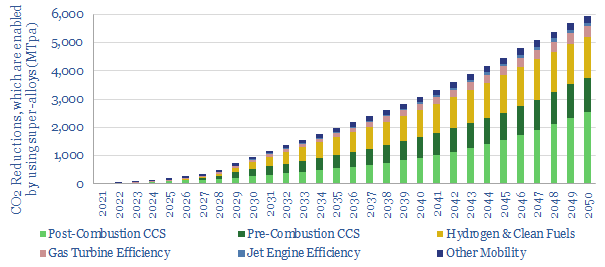Super-alloys have exceptionally high strength and temperature resistance. They help to enable 6GTpa of decarbonization, across efficient gas turbines, jet engines (whether fueled by oil, hydrogen or e-fuels), vehicle parts, CCS, and geopolitical resiliency. Hence this 15-page report explores nickel-niobium super-alloys’ role in energy transition.
Super-alloys are blends of metals, with crystal structures that confer high strength, high temperature resistance, and/or resiliency to oxidation and corrosion. As rules-of-thumb, super-alloys can withstand 1,000MPa of stress at room temperature, and still withstand 500MPa of stress even as temperatures surpass 1,000ºC. These material properties are explained on pages 2-3.
Gas turbines and jet engines use super-alloys for greater efficiency, which is directly linked to turbine inlet temperatures, thanks to the physics of the Brayton Cycle (note here). Super-alloys are currently being developed that could improve efficiency by 5-7pp. Opportunities and implications are discussed on pages 4-5.
Pipelines, especially CCS pipelines, will blend in traces of super-alloys, so that they can flow greater volumes at higher pressures. Materials typically only comprise 10-30% of the costs of pipelines, so it makes economic sense to up-spec materials. Barlow’s Formula and other economic considerations are on pages 6-7.
Other deployments of super-alloys will enable decarbonization themes such as more efficient vehicles (page 8), clean fuels such as hydrogen or blue ammonia (page 9), and around half of the market is currently linked to aerospace and defense spending, which matters for geopolitical security? (page 10).
Super-alloys role in energy transition. How are super-alloys made, what do they cost, and what is their CO2 intensity? The note focuses upon nickel value chains and niobium. We have condensed the most important considerations onto pages 11-12.
Leading companies in super-alloys are concentrated across a handful of specialists. Some are divisions of large industrial conglomerates, and others are pure-plays. Names that stood out in our screens are summarized on pages 13-15.

